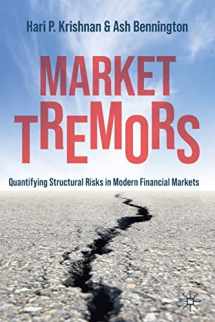
Market Tremors: Quantifying Structural Risks in Modern Financial Markets
Book details
Summary
Description
Product Description
Since the Global Financial Crisis, the structure of financial markets has undergone a dramatic shift. Modern markets have been “zombified” by a combination of Central Bank policy, disintermediation of commercial banks through regulation, and the growth of passive products such as ETFs. Increasingly, risk builds up beneath the surface, through a combination of excessive leverage and crowded exposure to specific asset classes and strategies. In many cases, historical volatility understates prospective risk. This book provides a practical and wide ranging framework for dealing with the credit, positioning and liquidity risk that investors face in the modern age. The authors introduce concrete techniques for adjusting traditional risk measures such as volatility during this era of unprecedented balance sheet expansion.
When certain agents in the financial network behave differently or in larger scale than they have in the past, traditional portfolio theory breaks down. It can no longer account for toxic feedback effects within the network. Our feedback-based risk adjustments allow investors to size their positions sensibly in dangerous set ups, where volatility is not providing an accurate barometer of true risk.
The authors have drawn from the fields of statistical physics and game theory to simplify and quantify the impact of very large agents on the distribution of forward returns, and to offer techniques for dealing with situations where markets are structurally risky yet realized volatility is low. The concepts discussed here should be of practical interest to portfolio managers, asset allocators, and risk professionals, as well as of academic interest to scholars and theorists.
From the Back Cover
Since the Global Financial Crisis, the structure of financial markets has undergone a dramatic shift. Modern markets have been “zombified” by a combination of Central Bank policy, disintermediation of commercial banks through regulation, and the growth of passive products such as ETFs. Increasingly, risk builds up beneath the surface, through a combination of excessive leverage and crowded exposure to specific asset classes and strategies. In many cases, historical volatility understates prospective risk.
This book provides a practical and wide ranging framework for dealing with the credit, positioning and liquidity risk that investors face in the modern age. The authors introduce concrete techniques for adjusting traditional risk measures such as volatility during this era of unprecedented balance sheet expansion.
When certain agents in the financial network behave differently or in larger scale than they have in the past, traditional portfolio theory breaks down. It can no longer account for toxic feedback effects within the network. Our feedback-based risk adjustments allow investors to size their positions sensibly in dangerous set ups, where volatility is not providing an accurate barometer of true risk.
The authors have drawn from the fields of statistical physics and game theory to simplify and quantify the impact of very large agents on the distribution of forward returns, and to offer techniques for dealing with situations where markets are structurally risky yet realized volatility is low. The concepts discussed here should be of practical interest to portfolio managers, asset allocators, and risk professionals, as well as of academic interest to scholars and theorists.
Hari P. Krishnan is head of volatility strategies at SCT Capital in New York. He was formerly a portfolio manager at Doherty Advisors in New York, a fund manager at CrossBorder Capital in London, an executive director at Morgan Stanley focused on asset allocation, and an options trading strategist for a market-making firm at the CBOE. He was a research scientist at the Columbia Earth Institute after receiving a PhD in applied math from Brown University and a BA in math from Columbia University.
Ash


We would LOVE it if you could help us and other readers by reviewing the book
Book review



